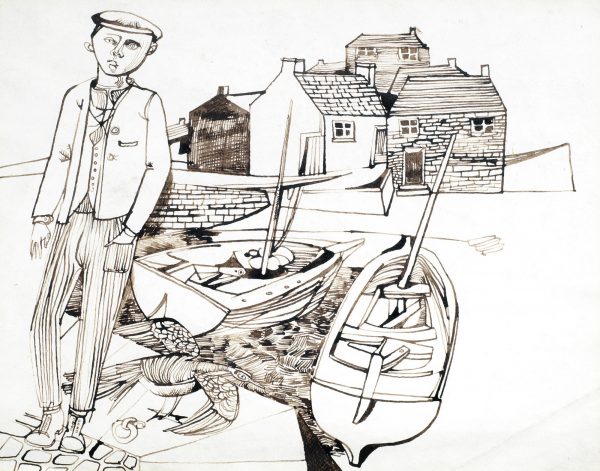Nocturnal landscapes and cityscapes illuminated by silvery, crescent moons, ruined cottages covered in tangles of undergrowth and anxious figures sheltering in shadowy woodlands and bombed-out streets – all hallmarks of British neo-romanticism.
A spotlight is being shone on this movement that produced some of the most innovative and captivating works of art in the mid-20th century in a free exhibition opening in July at the Fry Art Gallery.
The Fry holds a collection of works by neo-romantic artists who lived and worked in north west Essex, and is joining forces with The Ingram Collection of Modern British Art to explore this movement through an exhibition of 30 works by artists Graham Sutherland (1903-1980), John Piper (1903-1992), Keith Vaughan (1912-1977), John Craxton (1922-2009), John Minton (1917-1957), Robert McBryde (1913-1966), Robert Colquhoun (1914-1962) and Michael Ayrton (1921-1975).
Neo-romanticism infiltrated key areas of British creative life from the 1930s to the end of the 1950s and was characterized by a renewed interest in the Romantic era’s artistic and literary themes. This movement was a reaction to the dominant style of the time, which was abstract expressionism, and its artists sought a more intuitive, subjective approach to artmaking and to revive a sense of the mystical, imaginative, and emotional in art.
The works often feature strong narrative elements, evoking a sense of mystery and symbolism that invites the viewer to delve deeper into the hidden meanings behind the images. There is an all-pervading sense of nostalgia, foreboding and claustrophobia and this can partly be explained by the anxiety generated by the Second World War and the nightly blackouts which plunged the country into years of darkness and uncertainty.
Graham Sutherland and John Piper led the way in developing highly poetic paintings partly inspired by the visions of Samuel Palmer (1805-1881) and William Blake (1757-1827) and partly by a more general emotional response to the British landscape and its history. Examples in the exhibition will include Tin Mine, various aspects and Ideas for composition of miners drilling in a confined stope (both 1942) by the former, and The Ship (1937) Rockface under Tryfan, North Wales (1950) by the latter, all Ingram Collection.
John Minton was another leading figure in this movement, known for his deeply atmospheric paintings and prints. He often depicted lonely figures in desolate landscapes, evoking a sense of the sublime and the uncanny, such as The Hop Pickers (1945) and On the Quay, Cornwall (circa 1944), both from the Ingram Collection.
Keith Vaughan was another prominent neo-romantic artist, known for his introspective, melancholic works that explored the themes of human isolation and the search for meaning in a rapidly changing world. Vaughan works in the show include Figure Throwing at a Wave (1950) and The Garden at Ashton Gifford (1942), both Ingram Collection, and The Walled Garden (1951) and Two Studies of Outhouses (1955), both Fry Art Gallery.
Robert Colquhoun and Robert MacBryde were a pair of Scottish artists who worked collaboratively, producing striking figurative paintings that were often surreal and fantastical- demonstrated in the show by Masked Figures with Horse (1953) and Seated Woman (1952) by the former and Woman at Table (1948) and Still life with an oil lamp (1955-60) by the latter, all from the Fry Art Gallery. Michael Ayrton was another artist associated with the movement, known for his sculptures and drawings that often drew on Greek mythology and ancient history, such as Study on the theme of Temptation of St Anthony (1943, Ingram Collection) and Conversations in the Wind (1948, Fry Art Gallery)
John Craxton was a painter who was heavily influenced by his travels in Greece and the Mediterranean, and his works often featured vivid, dreamlike scenes of rural life and mythological subjects, such as Greek Dancer (1952), Landscape, Tresco (1954) and Girl with scarf by the sea (1957), all Ingram Collection.
A World of Private Mystery: British Neo-Romantics
8 July – 29 October 2023
Fry Art Gallery
19a Castle St, Saffron Walden CB10 1BD
Free entry
The Fry Public Art Gallery in Saffron Walden was opened in 1987 and houses an impressive number of paintings, prints, illustrations, wallpapers and decorative designs by artists of the 20th century and the present day who have local connections and have made a significant contribution to their field. There is an emphasis on those who for a variety of reasons settled in Great Bardfield between the early thirties of the last century and the death in 1983 of John Aldridge RA (who had lived in the village for 50 years), such as friends Edward Bawden and Eric Ravilious with their artist wives Charlotte Epton and Tirzah Garwood.

